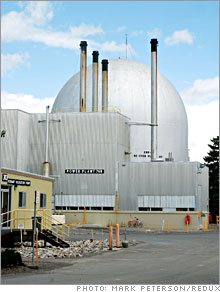David Whitford, Fortune editor-at-large
(Fortune) -- There is a remote valley in southeastern Idaho -- 890 square miles; desolate, dry and stunningly beautiful -- that is the place to go for atomic lore. It's the home of the Idaho National Laboratory (INL), where on December 20, 1951, scientists succeeded for the first time in converting nuclear power into electricity. They lit four 75-watt light bulbs. The next day they lit the whole lab.
Other experiments were less successful. Outside the building housing Experimental Breeder Reactor-1 (and the light bulbs it illuminated), in the corner of the parking lot, sit two dinosaur-like relics of the Cold War.
 |
| The Idaho Lab is currently operating three test reactors. |
The industry is gearing up to build its first new plants in decades.
How bad was the accident really?
The industry is coming alive in the Midwest's Ohio Valley.
Will power companies foot the bill?
It's not easy building a home for spent radioactive material.
• In search of safe nukes
An Idaho lab is at work on next generation reactors that promise to deliver more reliable energy.
"Back in the 1950s," my guide explains, "the US fully believed that the Soviets had built nuclear powered airplanes. At the time we did not have intercontinental ballistic missiles and we could not refuel bombers in flight yet, so that was seen as a priority for the Air Force: to build a nuclear powered bomber that could stay in the air for weeks or even months at a time."
So INL scientists designed and built two air-cooled nuclear reactors/jet engines, and they worked, sort of. "Only problem was the weight-to-thrust ratio still didn't quite pan out because the reactors" -- at 226 tons each -- "were enormous." In other words, they'd never fly. President Kennedy scrapped the program in March 1963.
By then the United States had plenty of missiles it could throw at the Russians, of course, and had learned how to refuel bombers in flight, and by the way had developed fresh intelligence on the Russian nuclear air fleet. Like WMDs in Iraq, it seems, they never existed.
Today INL researchers are working on several initiatives that will help define nuclear power's future. One is the Global Nuclear Energy Partnership, or GNEP, which the Bush administration has been pushing for the past couple of years. GNEP has several goals. One is to reduce nuclear proliferation by providing fuel suitable for nuclear power plants (but not nuclear weapons) to nations willing to submit to international oversight.
Another is to reduce the volume of nuclear waste by reprocessing spent fuel so that part of it can be reused. GNEP wouldn't eliminate the need for a nuclear waste disposal site like Yucca Mountain, whose development has been stalled since 1997. But it could give us another couple of decades before we have to open another Yucca Mountain. It could also mean that whatever waste we're left with will have a much shorter radioactive life, and therefore won't need to be stored as long.
Next generation
Other INL researchers are helping to develop the next generation of nuclear reactors, known as Generation IV -- potentially safer, more reliable and more versatile (with applications in the coming hydrogen economy) than anything available today. Project director Phil Hildebrandt is hoping to deploy a Gen-IV demonstration reactor by 2018 and have a design that's ready for commercialization by 2025.
Admittedly, that's an optimistic timetable. On the other hand, we're talking about an industry that went from powering four light bulbs to generating 16% of the world's electricity in 50 years. Even David Lochbaum of the Union of Concerned Scientists, a staunch critic of the nuclear power industry, rates that an extraordinary accomplishment.
Then he draws his own conclusions, relating to wind, solar and other sources of renewable energy not yet discovered. "If we look forward 50 years," says Lochbaum, "I don't see why we can't make the same kind of [progress], or even better, with renewables."
Email: dwhitford@fortunemail.com 